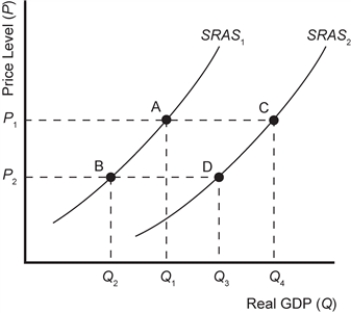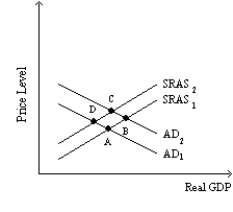Correct Answer

verified
Correct Answer
verified
Multiple Choice
As interest rates rise,the ____________ curve shifts _____________ resulting in a(n) _________________ in the price level and a(n) ________________ in Real GDP.
A) AD;leftward;decrease;decrease
B) AD;rightward;increase;increase
C) SRAS;rightward;decrease;increase
D) SRAS;leftward;increase;decrease
Correct Answer

verified
Correct Answer
verified
Multiple Choice
If consumption changes because of a change in a factor other than the price level,then the
A) economy moves from one point on an AD curve to another point on the same curve.
B) AD curve shifts.
C) economy moves from one point on a short-run aggregate supply (SRAS) curve to another point on the same curve.
D) SRAS curve shifts.
E) none of the above
Correct Answer

verified
Correct Answer
verified
Multiple Choice
Exhibit 8-4  -Refer to Exhibit 8-4.A shift in short-run aggregate supply from SRAS2 to SRAS1 could have been the result of
-Refer to Exhibit 8-4.A shift in short-run aggregate supply from SRAS2 to SRAS1 could have been the result of
A) a decrease in the price level.
B) an increase in the price level.
C) an increase in wage rates.
D) a decrease in wage rates.
Correct Answer

verified
Correct Answer
verified
Multiple Choice
If the nominal wage is $12 per hour and the price level (as measured by a price index) is 2,it follows that the real wage is _________ per hour.
A) $24.00
B) $6.00
C) $2.50
D) $14.00.
E) none of the above
Correct Answer

verified
Correct Answer
verified
Multiple Choice
An increase in labor's productivity will cause the SRAS curve to shift __________ and the price level to __________.
A) leftward;increase
B) rightward;decrease
C) rightward;increase
D) leftward;decrease
Correct Answer

verified
Correct Answer
verified
Multiple Choice
Exhibit 8-1  -Refer to Exhibit 8-1.Assume the economy is originally in equilibrium at point A.If wage rates rise,at which point is the economy most likely to end up in the short run?
-Refer to Exhibit 8-1.Assume the economy is originally in equilibrium at point A.If wage rates rise,at which point is the economy most likely to end up in the short run?
A) A
B) B
C) C
D) D
Correct Answer

verified
Correct Answer
verified
True/False
The level of Real GDP that the economy produces in long-run equilibrium is Natural Real GDP.
Correct Answer

verified
Correct Answer
verified
Multiple Choice
A change in the quantity demanded of Real GDP is graphically represented as a
A) shift in the AD curve.
B) movement from one point on the AD curve to another point on the same curve.
C) movement from a point on the AD curve to a point on the SRAS curve.
D) shift in the real balance effect curve.
E) shift in the interest rate effect curve.
Correct Answer

verified
Correct Answer
verified
Multiple Choice
The short-run aggregate supply (SRAS) curve shows the quantity
A) demanded of all goods and services at different price levels,ceteris paribus.
B) supplied of all goods and services at a particular price level,ceteris paribus.
C) supplied of all goods and services at different price levels,ceteris paribus.
D) supplied of GDP at a particular price level,ceteris paribus.
Correct Answer

verified
Correct Answer
verified
Multiple Choice
Which of the following statements is false?
A) Some prices in an economy adjust faster than other prices.
B) Aggregate demand curves slope downward.
C) Firms may not adjust their prices immediately because they may be unable to figure out whether a decline in demand is temporary or permanent.
D) The absolute price of a good is the dollar or money price of the good.
E) none of the above
Correct Answer

verified
Correct Answer
verified
Multiple Choice
The AD curve shows the various amounts of real output that people are willing and able to
A) buy at different income levels.
B) buy at different price levels.
C) sell at different profit levels.
D) sell at different price levels.
E) none of the above
Correct Answer

verified
Correct Answer
verified
Multiple Choice
A rise in wage rates
A) causes the AD curve to shift leftward.
B) causes the short-run aggregate supply (SRAS) curve to shift rightward.
C) does not affect the present position of the SRAS curve.
D) causes the AD curve to shift rightward.
E) causes the SRAS curve to shift leftward.
Correct Answer

verified
Correct Answer
verified
Multiple Choice
An increase in the interest rate __________ purchases of consumer __________.
A) increases;durables
B) increases;nondurables
C) reduces;durables
D) reduces;nondurables
Correct Answer

verified
Correct Answer
verified
Multiple Choice
Business taxes fall.This raises __________,which raises __________ and the __________ curve shifts rightward.
A) consumption;aggregate demand (AD) ;AD
B) investment;government purchases;AD
C) investment;aggregate demand (AD) ;AD
D) net exports;aggregate demand (AD) ;AD
E) none of the above
Correct Answer

verified
Correct Answer
verified
Multiple Choice
Exhibit 8-1  -Refer to Exhibit 8-1.Assume that the economy is originally in equilibrium at point B.If businesses become pessimistic about future sales,at which point is the economy most likely to end up in the short run?
-Refer to Exhibit 8-1.Assume that the economy is originally in equilibrium at point B.If businesses become pessimistic about future sales,at which point is the economy most likely to end up in the short run?
A) A
B) B
C) C
D) D
Correct Answer

verified
Correct Answer
verified
Multiple Choice
A rise in the price level prompts an increase in the demand for credit.This is relevant to the __________ effect.
A) international trade
B) real balance
C) aggregate demand
D) interest rate
E) b and c
Correct Answer

verified
Correct Answer
verified
Multiple Choice
A decrease in the price of a nonlabor input such as electricity will cause
A) a movement down the SRAS curve.
B) a movement up the SRAS curve.
C) a leftward shift in the SRAS curve.
D) a rightward shift in the SRAS curve.
E) no change regarding the SRAS curve.
Correct Answer

verified
Correct Answer
verified
Multiple Choice
Exhibit 8-1  -Refer to Exhibit 8-1.If we assume that Real GDP and the unemployment rate are inversely related,which of the points on this graph is most likely representative of the highest unemployment rate?
-Refer to Exhibit 8-1.If we assume that Real GDP and the unemployment rate are inversely related,which of the points on this graph is most likely representative of the highest unemployment rate?
A) A
B) B
C) C
D) D
Correct Answer

verified
Correct Answer
verified
Multiple Choice
Starting from short-run equilibrium,the following occurs: the U.S.dollar depreciates and wage rates rise.Moreover,the effect on the economy from the dollar depreciating is stronger than the effect on the economy from rising wage rates.What is the effect on the price level and Real GDP in the short run?
A) The price level falls and Real GDP falls.
B) The price level rises and Real GDP falls.
C) The price level falls and Real GDP rises.
D) The price level rises and Real GDP rises.
E) none of the above
Correct Answer

verified
Correct Answer
verified
Showing 141 - 160 of 203
Related Exams